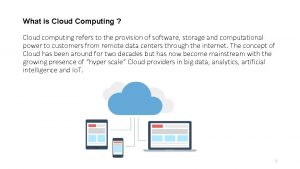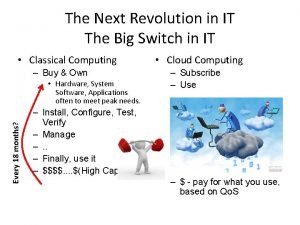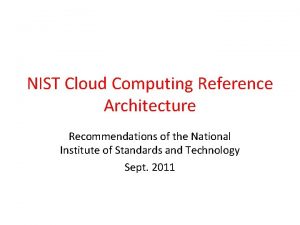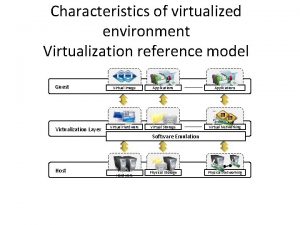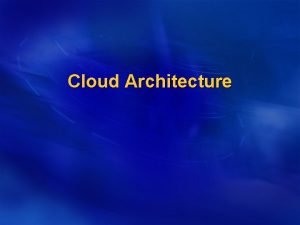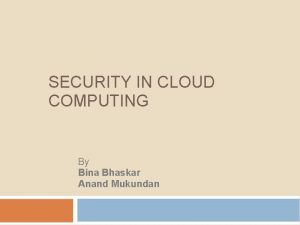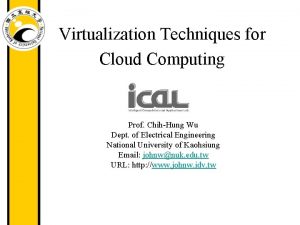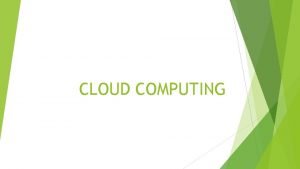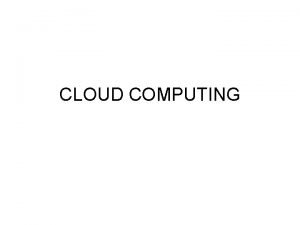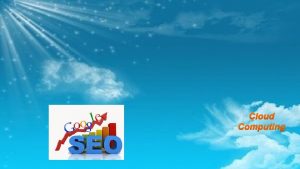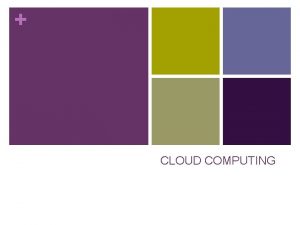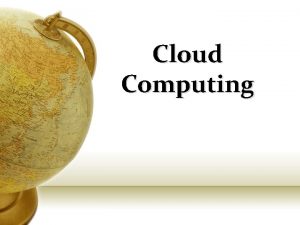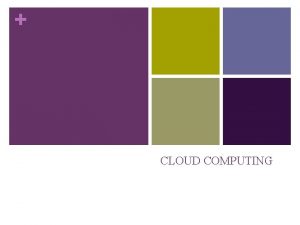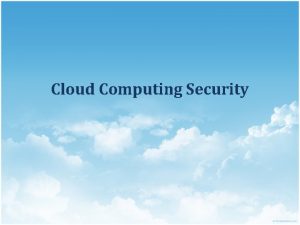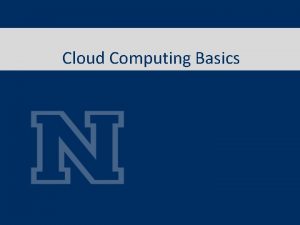Cloud Computing Cloud computing refers to a model












- Slides: 12

Cloud Computing • Cloud computing refers to “a model of computing that provides access to a shared pool of computing resources (computers, storage, applications, and services), over a network, often the Internet”. • These resources are made available to users, based on their needs, irrespective of their physical location or the location of the users themselves.

Essential Characteristics • The U. S. National Institute of Standards and Technology (NIST) defines cloud computing as having the following essential characteristics: ü On-demand self-service: – Individuals can obtain computing capabilities such as server time or network storage on their own. ü Ubiquitous network access: – Individuals can use standard network and Internet devices, including mobile platforms, to access cloud resources.

Essential Characteristics ü Location independent resource pooling: – Computing resources are pooled to serve multiple users, with different virtual resources dynamically assigned according to user demand. – The user generally does not know where the computing resources are located. ü Rapid elasticity: – Computing resources can be rapidly provisioned, increased, or decreased to meet changing user demand. ü Measured service: – Charges for cloud resources are based on amount of resources actually used.

Types of Services • Cloud computing consists of three different types of services: ü Cloud infrastructure as a service (Iaa. S) ü Cloud platform as a service (Paa. S) ü Cloud software as a service (Saa. S)

Cloud Infrastructure as a Service (Iaa. S) • Customers use processing, storage, networking, and other computing resources from cloud service providers to run their information systems. • For example, Amazon uses the spare capacity of its IT infrastructure to provide a broadly based cloud environment selling IT infrastructure services. ü These include its Simple Storage Service (S 3) for storing customers’ data and its Elastic Compute Cloud (EC 2) service for running their applications. ü Users pay only for the amount of computing and storage capacity they actually use.

Cloud Platform as a Service (Paa. S) • Customers use infrastructure and programming tools hosted by the service provider to develop their own applications. • For example, IBM offers a Smart Business Application Development & Test service for software development and testing on the IBM Cloud. • Another example is Salesforce. com which allows developers to build applications that are hosted on its servers as a service.

Cloud Software as a Service (Saa. S) • Customers use software hosted by the vendor on the vendor’s hardware and delivered over a network. • Leading examples are Google Apps, which provides common business applications online, and Salesforce. com, which also leases CRM and related software services over the Internet. • Both charge users an annual subscription fee, although Google Apps also has a pared-down free version. • Users access these applications from a Web browser, and the data and software maintained on the providers’ remote servers.

Public vs. Private Clouds • A public cloud is maintained by an external service provider, such as Amazon Web Services, accessed through the Internet, and available to the general public. • A private cloud is a proprietary network or a data center that ties together servers, storage, networks, data, and applications as a set of virtualized services that are shared by users inside a company. • Financial institutions and health care providers are likely to gravitate toward private clouds because these organizations handle so much sensitive financial and personal data.

Cloud Computing • Since organizations using cloud computing generally do not own the infrastructure, they do not have to make large investments in their own hardware and software. • Instead, they purchase their computing services from remote providers and pay only for the amount of computing power they actually use or are billed on a monthly or annual subscription basis.

Drawbacks of Cloud Computing • Unless users make provisions for storing their data locally, the responsibility for data storage and control is in the hands of the provider. • Some companies worry about the security risks related to entrusting their critical data and systems to an outside vendor that also works with other companies. • Companies expect their systems to be available 24/7 and do not want to suffer any loss of business capability if their IT infrastructures malfunction. • Another limitation of cloud computing is the possibility of making users dependent on the cloud computing provider.

Cloud Computing • Cloud computing is more immediately appealing to small and medium-sized businesses that lack resources to purchase and own their own hardware and software. • However, large corporations have huge investments in complex proprietary systems supporting unique business processes, some of which give them strategic advantages. • For them, the most likely scenario is a hybrid computing model where firms use their own infrastructure for their most essential core activities and adopt public cloud computing for less-critical systems or for additional processing capacity during peak business periods.

Cloud Computing • Cloud computing will gradually shift firms from having a fixed infrastructure capacity toward a more flexible infrastructure, some of it owned by the firm, and some of it rented from giant computer centers owned by computer hardware vendors.
 Cloud computing refers to
Cloud computing refers to Traditional cloud computing
Traditional cloud computing Cloud computing reference model
Cloud computing reference model Reference
Reference Virtualization environment
Virtualization environment Spi model in cloud computing
Spi model in cloud computing Bina bhaskar
Bina bhaskar Electron cloud diagram
Electron cloud diagram Conventional computing and intelligent computing
Conventional computing and intelligent computing Vodafone cloud computing
Vodafone cloud computing Full virtualization in cloud computing
Full virtualization in cloud computing Virtualization structure in cloud computing ppt
Virtualization structure in cloud computing ppt Type of cloud
Type of cloud

